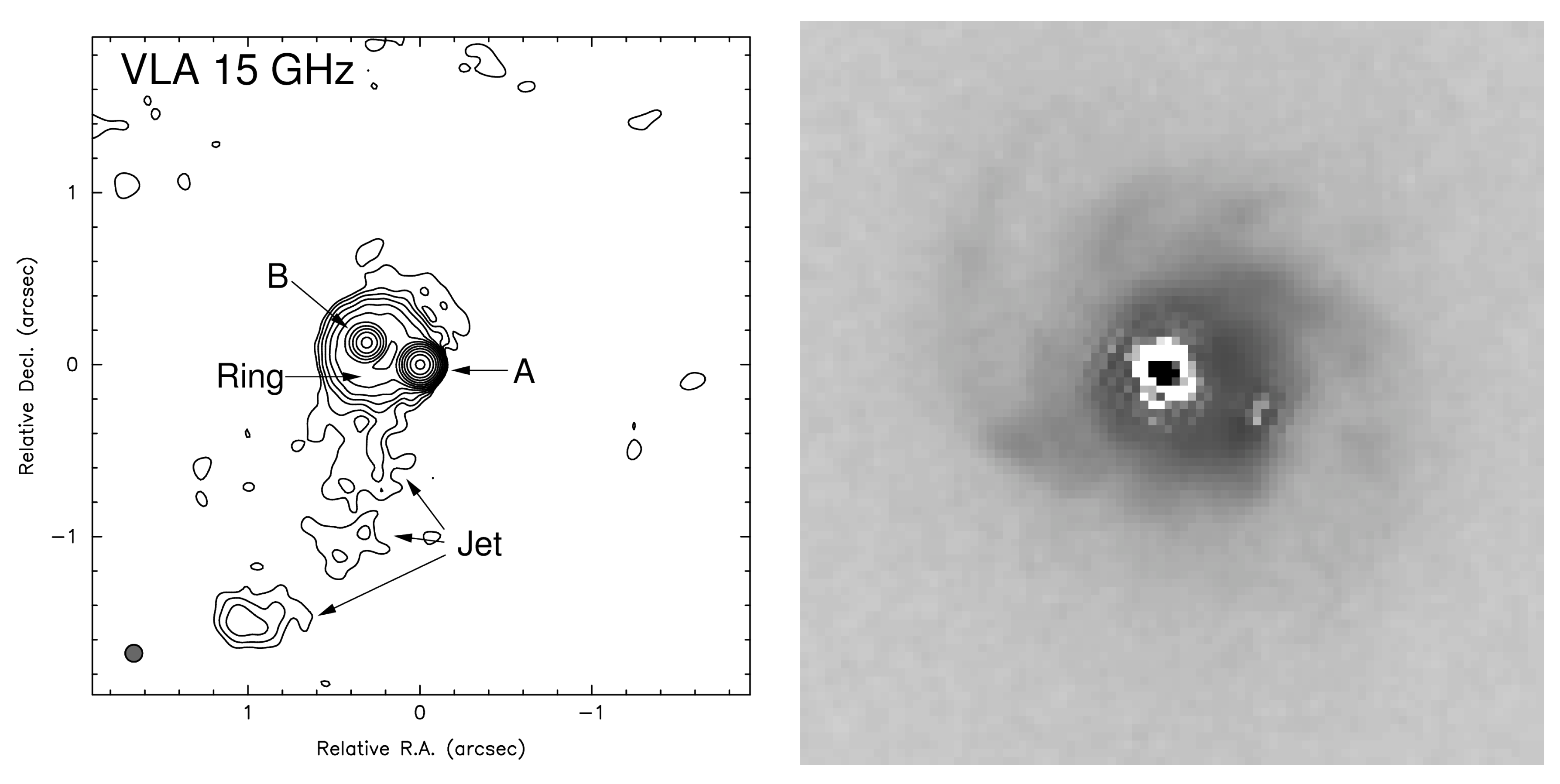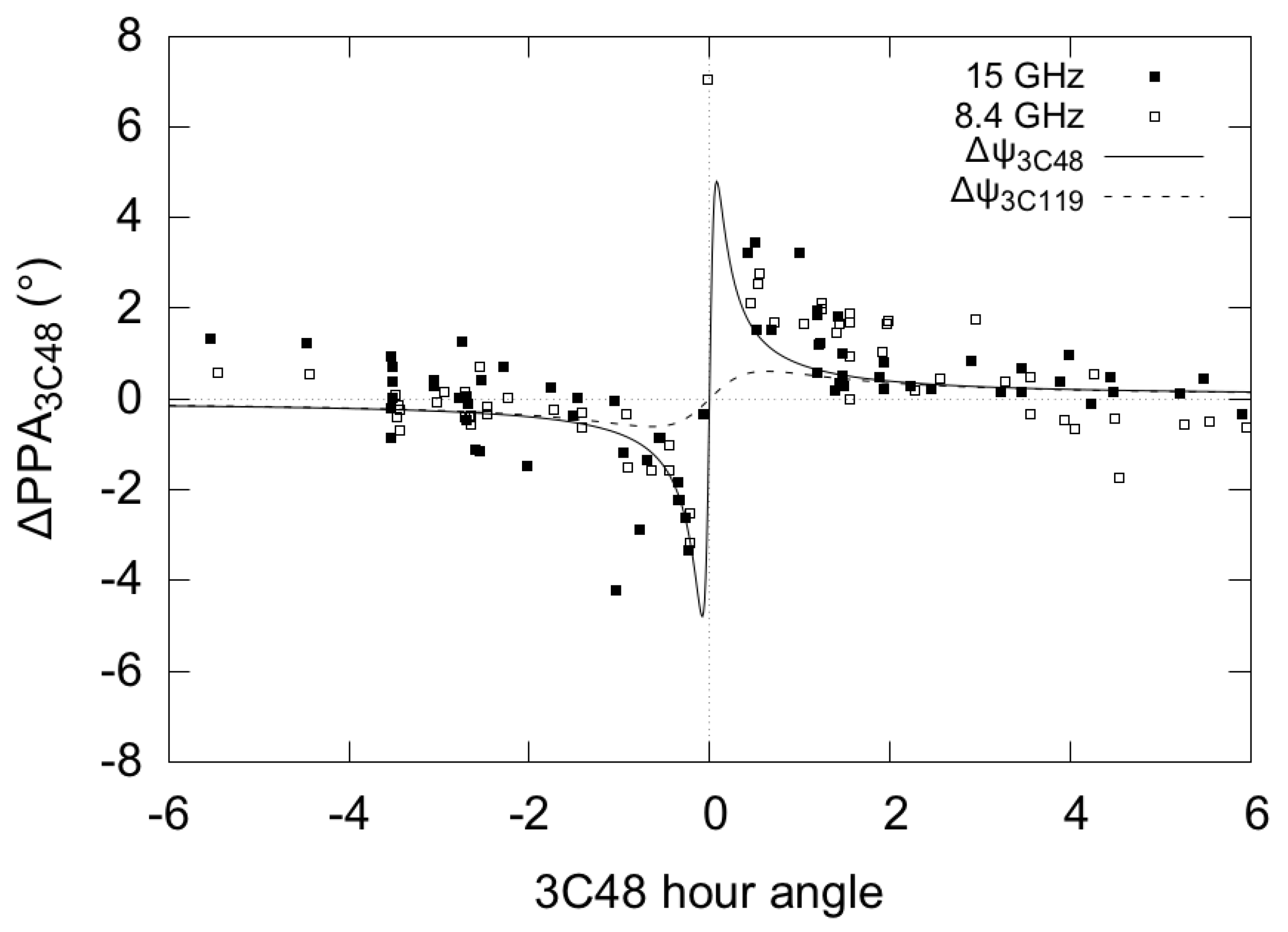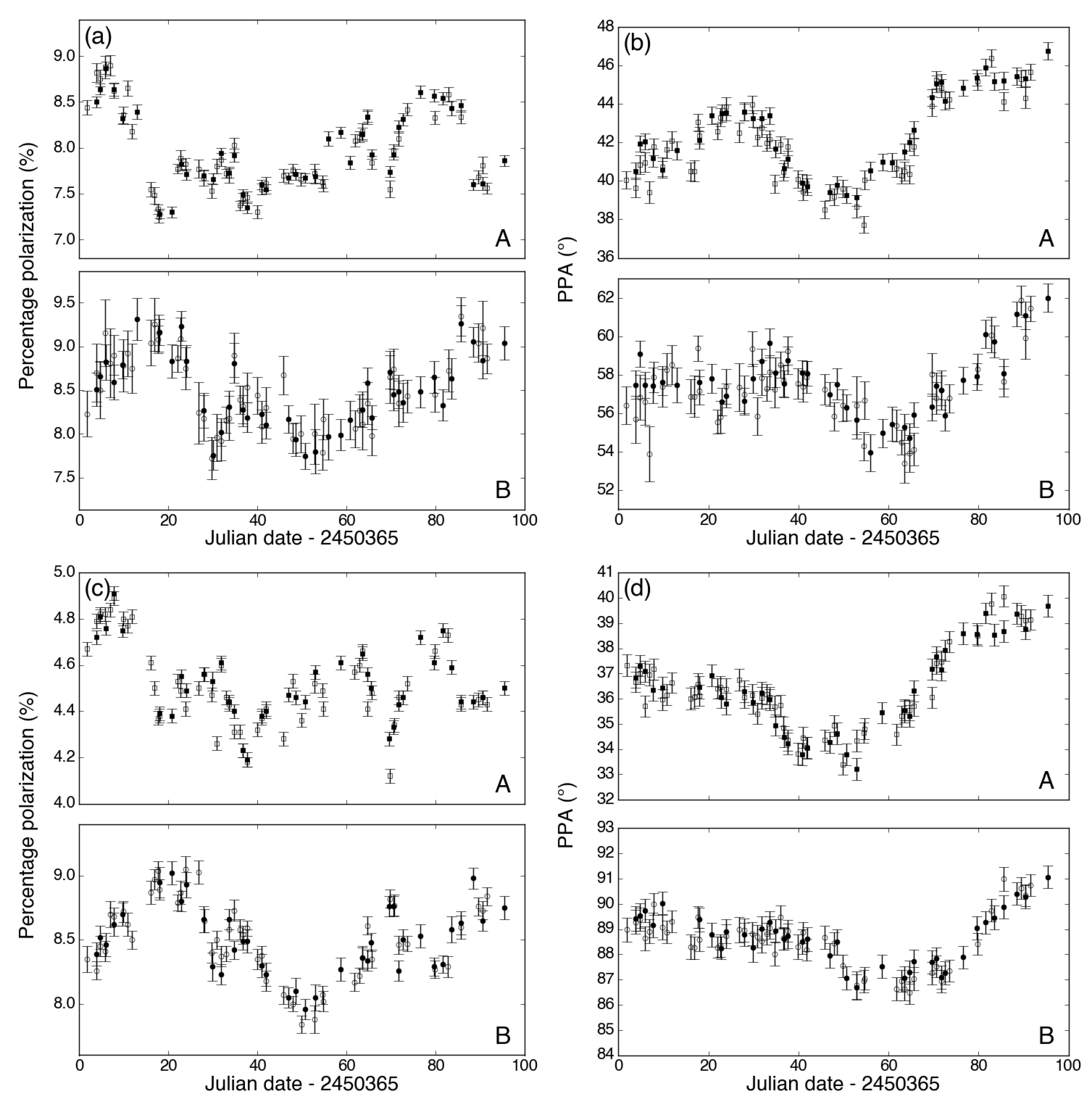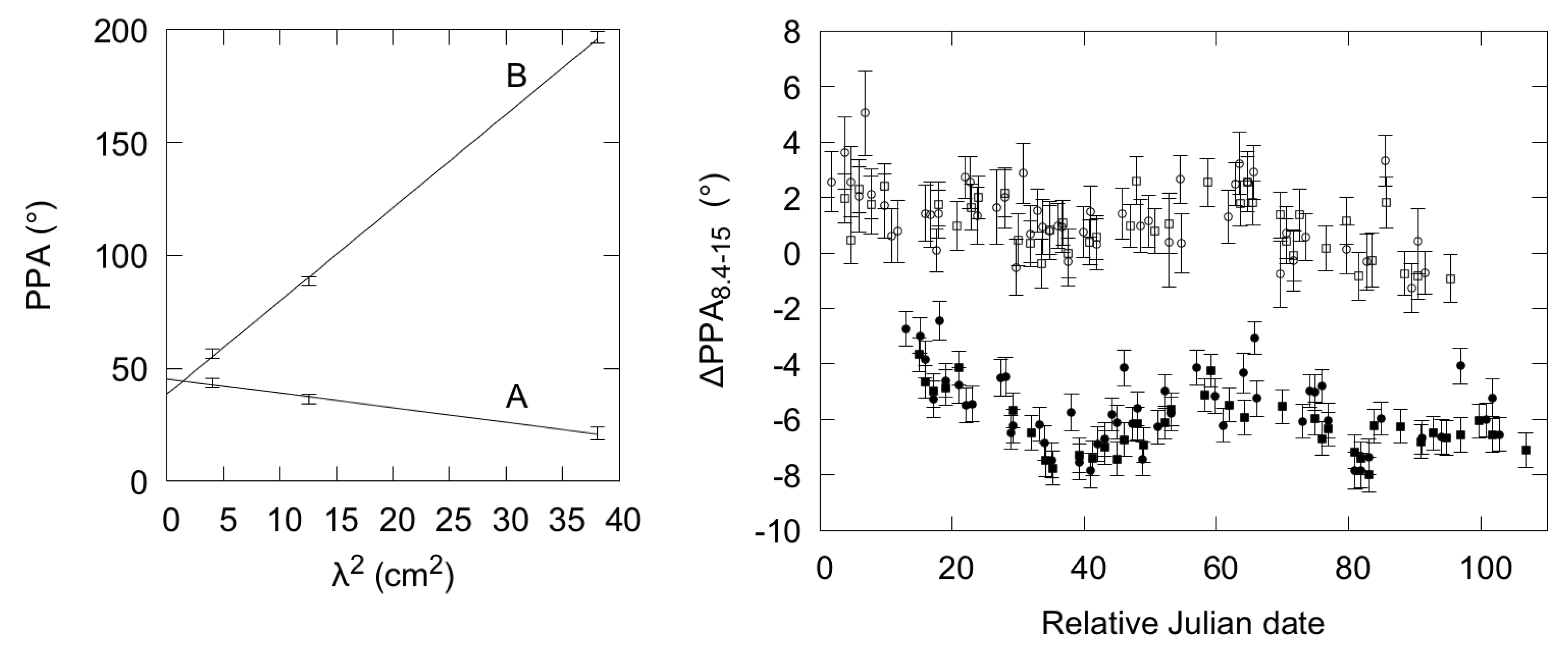Polarization Monitoring of the Lens System JVAS B0218+357
Abstract
:1. Introduction
2. Materials and Methods
3. Results
3.1. Variability Curves
3.2. Time-Delay Analysis
3.3. Faraday Effects
4. Discussion
Acknowledgments
Author Contributions
Conflicts of Interest
References
- Browne, I.W.A.; Patnaik, A.R.; Walsh, D.; Wilkinson, P.N. The Redshift of the Lensing Galaxy in the Gravitationally Lensed System B0218+35.7. Mon. Not. R. Astron. Soc. 1993, 263, L32–L36. [Google Scholar] [CrossRef]
- King, L.J.; Browne, I.W.A.; Marlow, D.R.; Patnaik, A.R.; Wilkinson, P.N. Gravitationally lensed radio sources in the Jodrell Bank-VLA Astrometric Survey. Mon. Not. R. Astron. Soc. 1999, 307, 225–235. [Google Scholar] [CrossRef]
- Refsdal, S. On the possibility of determining Hubble’s parameter and the masses of galaxies from the gravitational lens effect. Mon. Not. R. Astron. Soc. 1964, 128, 307–310. [Google Scholar] [CrossRef]
- Wucknitz, O.; Biggs, A.D.; Browne, I.W.A. Models for the lens and source of B0218+357: A LENSCLEAN approach to determine H0. Mon. Not. R. Astron. Soc. 2004, 349, 14–30. [Google Scholar] [CrossRef]
- Biggs, A.D.; Browne, I.W.A.; Helbig, P.; Koopmans, L.V.E.; Wilkinson, P.N.; Perley, R.A. Time delay for the gravitational lens system B0218+357. Mon. Not. R. Astron. Soc. 1999, 304, 349–358. [Google Scholar] [CrossRef]
- Cohen, A.S.; Hewitt, J.N.; Moore, C.B.; Haarsma, D.B. Further Investigation of the Time Delay, Magnification Ratios, and Variability in the Gravitational Lens 0218+357. Astrophys J. 2000, 545, 578–590. [Google Scholar] [CrossRef]
- York, T.; Jackson, N.; Browne, I.W.A.; Wucknitz, O.; Skelton, J.E. The Hubble constant from the gravitational lens CLASS B0218+357 using the Advanced Camera for Surveys. Mon. Not. R. Astron. Soc. 2005, 357, 124–134. [Google Scholar] [CrossRef]
- Cheung, C.C.; Larsson, S.; Scargle, J.D.; Amin, M.A.; Blandford, R.D.; Bulmash, D.; Chiang, J.; Ciprini, S.; Corbet, R.H.D.; Falco, E.E.; et al. Fermi Large Area Telescope Detection of Gravitational Lens Delayed γ-Ray Flares from Blazar B0218+357. Astrophys J. 2014, 782, L14. [Google Scholar] [CrossRef]
- Barnacka, A.; Geller, M.J.; Dell’Antonio, I.P.; Zitrin, A. The Structure of the Strongly Lensed Gamma-Ray Source B2 0218+35. Astrophys J. 2016, 821, 58. [Google Scholar] [CrossRef]
- Shepherd, M.C. Difmap: An Interactive Program for Synthesis Imaging; Astronomical Society of the Pacific: San Francisco, CA, USA, 1997; Volume 125, p. 77. [Google Scholar]
- Pelt, J.; Kayser, R.; Refsdal, S.; Schramm, T. The light curve and the time delay of QSO 0957+561. Astron. Astrophys. 1996, 305, 97–106. [Google Scholar]
- O’Dea, C.P.; Baum, S.A.; Stanghellini, C.; Dey, A.; van Breugel, W.; Deustua, S.; Smith, E.P. Radio and optical observations of 0218+357—The smallest Einstein ring? Astron. J. 1992, 104, 1320–1330. [Google Scholar] [CrossRef]
- Planck Collaboration; Ade, P.A.R.; Aghanim, N.; Arnaud, M.; Ashdown, M.; Aumont, J.; Baccigalupi, C.; Banday, A.J.; Barreiro, R.B.; Bartlett, J.G.; et al. Planck 2015 results. XIII. Cosmological parameters. Astron. Astrophys. 2016, 594, A13. [Google Scholar] [CrossRef]
- Riess, A.G.; Macri, L.M.; Hoffmann, S.L.; Scolnic, D.; Casertano, S.; Filippenko, A.V.; Tucker, B.E.; Reid, M.J.; Jones, D.O.; Silverman, J.M.; et al. A 2.4% Determination of the Local Value of the Hubble Constant. Astrophys J. 2016, 826, 56. [Google Scholar] [CrossRef]




© 2017 by the authors. Licensee MDPI, Basel, Switzerland. This article is an open access article distributed under the terms and conditions of the Creative Commons Attribution (CC BY) license (http://creativecommons.org/licenses/by/4.0/).
Share and Cite
Biggs, A.; Browne, I. Polarization Monitoring of the Lens System JVAS B0218+357. Galaxies 2017, 5, 69. https://doi.org/10.3390/galaxies5040069
Biggs A, Browne I. Polarization Monitoring of the Lens System JVAS B0218+357. Galaxies. 2017; 5(4):69. https://doi.org/10.3390/galaxies5040069
Chicago/Turabian StyleBiggs, Andrew, and Ian Browne. 2017. "Polarization Monitoring of the Lens System JVAS B0218+357" Galaxies 5, no. 4: 69. https://doi.org/10.3390/galaxies5040069





